Just open a dummy excel workbook. Create the dummy button like below:

The buttons are in the above picture are basic shapes. And “HP-PC” is the system name. If you open the file in your system, it will show your system name. And the time is coming from system’s time. After creating the above button we will create the code.
First, we are trying to focus on the Sales Report. You need to decide what will be the TSQL code for this. For Example, we need to prepare a report which will show the Name of the person and from which territory they have sold in what amount.
First of all, we need to check the TSQL code in SQL Server. I have written a simple which will pull up the records of person name and territory name and the sum of sales amount of current year and the last year. Here is my query in SQL server.

If I ran the above query in SQL Server I am getting 17 records.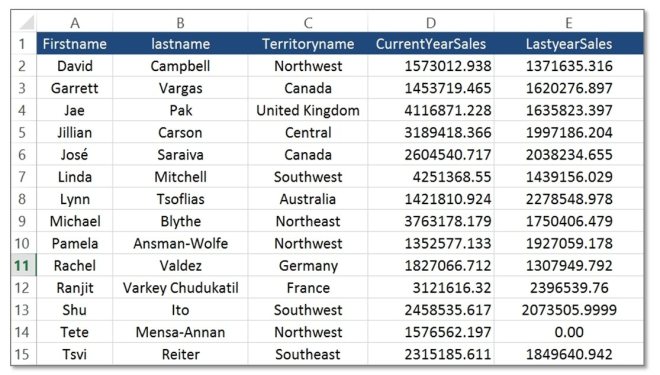 Now our intention is something different. We want the same result in Excel. You can copy the result and paste it in Excel sheet that is fine. But if you need to do the same thing every day and then you can simply copy the below code and paste it on VBA page and then connect the code with the button to get data from SQL to Excel, Please follow the below steps to get the result in Excel sheet:
Now our intention is something different. We want the same result in Excel. You can copy the result and paste it in Excel sheet that is fine. But if you need to do the same thing every day and then you can simply copy the below code and paste it on VBA page and then connect the code with the button to get data from SQL to Excel, Please follow the below steps to get the result in Excel sheet:
 Now our intention is something different. We want the same result in Excel. You can copy the result and paste it in Excel sheet that is fine. But if you need to do the same thing every day and then you can simply copy the below code and paste it on VBA page and then connect the code with the button to get data from SQL to Excel, Please follow the below steps to get the result in Excel sheet:
Now our intention is something different. We want the same result in Excel. You can copy the result and paste it in Excel sheet that is fine. But if you need to do the same thing every day and then you can simply copy the below code and paste it on VBA page and then connect the code with the button to get data from SQL to Excel, Please follow the below steps to get the result in Excel sheet:- Press Alt + F11 to go the VBA page
- Paste the below code
- Press F5 or run the code
Code:
Option Explicit
'The part extracting the body is taken from here
'https://support.microsoft.com/en-us/kb/306125
Sub GetData()
Dim cnLogs As New ADODB.Connection
Dim rsHeaders As New ADODB.Recordset
Dim rsData As New ADODB.Recordset
Dim l_counter As Long: l_counter = 0
Dim strConn As String
Sheets(1).UsedRange.Clear
strConn = "PROVIDER=SQLOLEDB;"
strConn = strConn & "DATA SOURCE=(local);INITIAL CATALOG=LogData;"
strConn = strConn & " INTEGRATED SECURITY=sspi;"
cnLogs.Open strConn
With rsHeaders
.ActiveConnection = cnLogs
.Open "SELECT * FROM syscolumns WHERE id=OBJECT_ID('LogTable')"
'.Open "SELECT * FROM INFORMATION_SCHEMA.COLUMNS WHERE TABLE_NAME = 'LogTable'"
'.Open "SELECT * FROM LogData.INFORMATION_SCHEMA.COLUMNS WHERE TABLE_NAME = N'LogTable'"
'.Open "SELECT * FROM SYS.COLUMNS WHERE object_id = OBJECT_ID('dbo.LogTable')"
Do While Not rsHeaders.EOF
Cells(1, l_counter + 1) = rsHeaders(0)
l_counter = l_counter + 1
rsHeaders.MoveNext
Loop
.Close
End With
With rsData
.ActiveConnection = cnLogs
.Open "SELECT * FROM LogTable"
Sheet1.Range("A2").CopyFromRecordset rsData
.Close
End With
cnLogs.Close
Set cnLogs = Nothing
Set rsHeaders = Nothing
Set rsData = Nothing
Sheets(1).UsedRange.EntireColumn.AutoFit
End Sub
Before running the code you need to change some setting. Go to tools on VBA page and then click on the reference and then select “Microsoft ActiveX Data Objects 2.8 Library and press OK.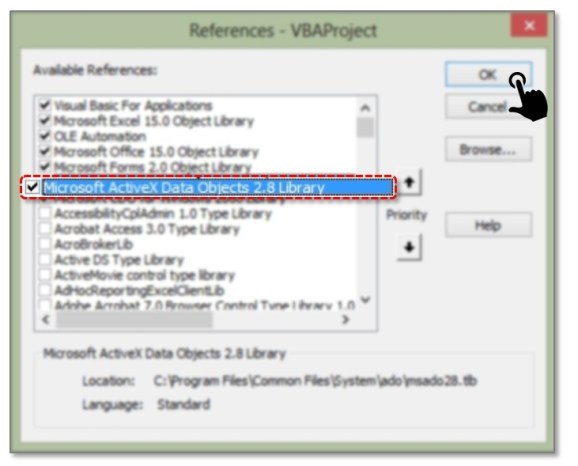 Now we all are good to go. Now press F5 to run the code. You will notice the same records are there in the excel sheet. Now if the data or any record is updated in the base table in SQL Server you will get the update result. Now all the time you will get the live data. That’s why it is powerful.
Now we all are good to go. Now press F5 to run the code. You will notice the same records are there in the excel sheet. Now if the data or any record is updated in the base table in SQL Server you will get the update result. Now all the time you will get the live data. That’s why it is powerful.
 Now we all are good to go. Now press F5 to run the code. You will notice the same records are there in the excel sheet. Now if the data or any record is updated in the base table in SQL Server you will get the update result. Now all the time you will get the live data. That’s why it is powerful.
Now we all are good to go. Now press F5 to run the code. You will notice the same records are there in the excel sheet. Now if the data or any record is updated in the base table in SQL Server you will get the update result. Now all the time you will get the live data. That’s why it is powerful.You can send the file to your manager or boss. He or she will get the updated report all the time. We need to assign the code to the button “Sales Report” we created earlier. Go to that button and then right-click on it and click on “Assign Macro”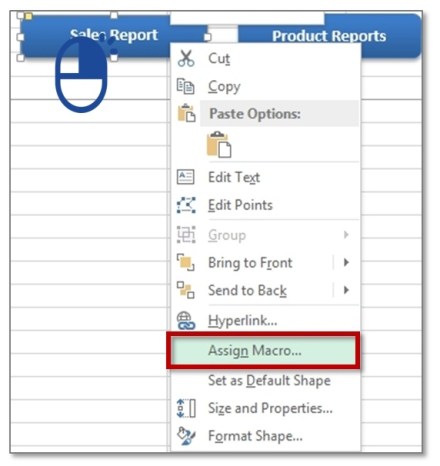 Then click on “New”. You will be redirected to the new VBA page. Just write “Call DataTakenFromSQLServer”. Finally, you are done. Whenever you click on the Sales Report you will get the updated result.
Then click on “New”. You will be redirected to the new VBA page. Just write “Call DataTakenFromSQLServer”. Finally, you are done. Whenever you click on the Sales Report you will get the updated result.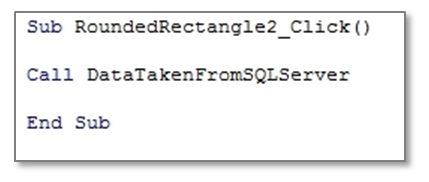 Now Go back to your sheet. And Click on the “Sales Report”. You will notice that the data is coming in the Excel sheet. Another one thing you will have to be careful that the SQL server service is on the form where the data is coming.
Now Go back to your sheet. And Click on the “Sales Report”. You will notice that the data is coming in the Excel sheet. Another one thing you will have to be careful that the SQL server service is on the form where the data is coming.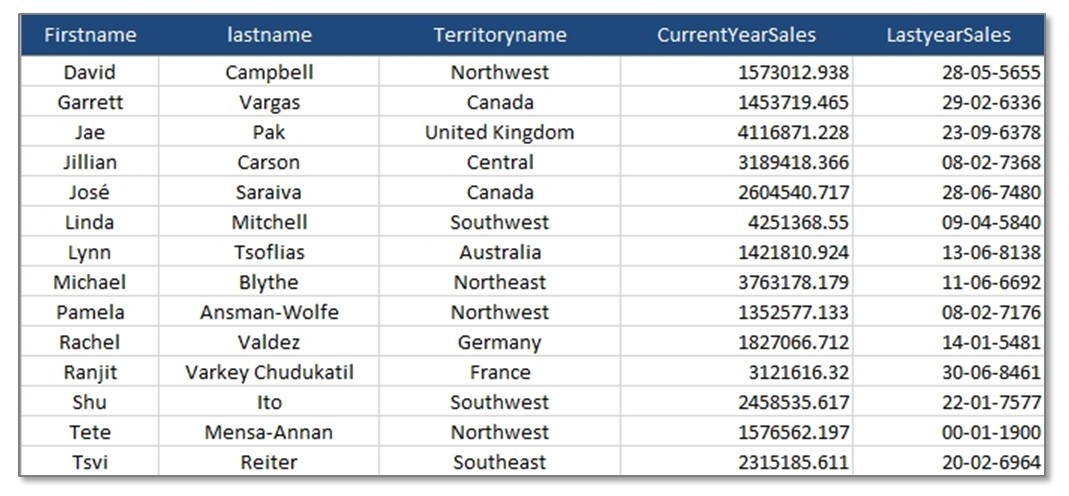 Please download the workbook from here and check the code. Please change the SQL server name and database name to check the output of your query. You can also write your own query and check whether it is working or not. Let us know if you have any problem understanding the code. We will help you out.
Please download the workbook from here and check the code. Please change the SQL server name and database name to check the output of your query. You can also write your own query and check whether it is working or not. Let us know if you have any problem understanding the code. We will help you out.
#evba #etipfree Then click on “New”. You will be redirected to the new VBA page. Just write “Call DataTakenFromSQLServer”. Finally, you are done. Whenever you click on the Sales Report you will get the updated result.
Then click on “New”. You will be redirected to the new VBA page. Just write “Call DataTakenFromSQLServer”. Finally, you are done. Whenever you click on the Sales Report you will get the updated result. Now Go back to your sheet. And Click on the “Sales Report”. You will notice that the data is coming in the Excel sheet. Another one thing you will have to be careful that the SQL server service is on the form where the data is coming.
Now Go back to your sheet. And Click on the “Sales Report”. You will notice that the data is coming in the Excel sheet. Another one thing you will have to be careful that the SQL server service is on the form where the data is coming. Please download the workbook from here and check the code. Please change the SQL server name and database name to check the output of your query. You can also write your own query and check whether it is working or not. Let us know if you have any problem understanding the code. We will help you out.
Please download the workbook from here and check the code. Please change the SQL server name and database name to check the output of your query. You can also write your own query and check whether it is working or not. Let us know if you have any problem understanding the code. We will help you out.📤You download App EVBA.info installed directly on the latest phone here : https://www.evba.info/p/app-evbainfo-setting-for-your-phone.html?m=1


























![[Free ebook] Excel Timesaving Techniques For Dummies](https://blogger.googleusercontent.com/img/b/R29vZ2xl/AVvXsEgzWyqaPosaS2VM-Nk1ab24vcKUwYTs711ThM9wp9xmavw0A3qGwRFO810Ck-OdOWZcBBky6MTqkpWRXlaZBidjaesv3AhqgLAVXQ-jUZj8erqehdQDFbSg8s0XB72D162a5fdjoeCaXCU/s72-c/2019_04_15_14.32.34_edit.jpg)
![[FREE EBOOK]101 Ready-to-Use Excel Formulas by Michael Alexander & Dick Kusleika](https://blogger.googleusercontent.com/img/b/R29vZ2xl/AVvXsEjlgcYWkmfYQbPJ8_2JubQnnsTSWEba0oUXWpGF53A6EOj30ZsVldkShWT3woS6WnNIDHMuTkRGl2Fnj8e86GA7-PRE1HEhKN6Yw_gJe00lzcxRpCXafd4IRO97ehk3PNQybVPn3k4q7r8/s72-c/101+Ready-to-Use+Excel+Formulas+by+Michael+Alexander+%2526+Dick+Kusleika.jpg)

![[Free ebook Download]Excel Formulas & Functions For Dummies by Ken Bluttman](https://blogger.googleusercontent.com/img/b/R29vZ2xl/AVvXsEhYetQg74WpM626jRfy2FNrD3T272FyEaS-6p2mBfAgithEES51mLuj76s7JDCrkb8SuwiaST1s6mox68MC6IwJYWkiFH6rRXYqnc513XGjRdYjeviLZii14QmxmThmh2D_ItCW1YTvd2k/s72-c/Excel+Formulas+%2526+Functions+For+Dummies+by+Ken+Bluttman.jpg)
![[FREE EBOOK DOWNLOAD]Excel Data Analysis For Dummies by Paul McFedries](https://blogger.googleusercontent.com/img/b/R29vZ2xl/AVvXsEgLCDTLwgLtY0xfs-YAIKyDdKhMVSIKsrnjL-GtIYwV7BD7oqVTMWc3cTR73ps7GtjNrZB5v84xN5ROGdf9_YW1oeTiV4mgMeIdfV7LZOiEBbJuY15C7Qch4jNUYd6Eb3oE_xmQUSrdfCI/s72-c/Excel+Data+Analysis+For+Dummies+by+Paul+McFedries.jpg)
![[Free ebook]Excel Dashboards and Reports for Dummies 3rd Edition - Michael Alexander](https://blogger.googleusercontent.com/img/b/R29vZ2xl/AVvXsEh9vLm6q3B9PFEAcLnQ4YrI5pH_KCv-CcunxTBBHZXcbA9rhd2RR2HchlVAguPCGRJupUJesFUkaff2DX7MCqOFwfLHU6LkePD5KMPLZB6V_9Xe64x9p_ntwaFpJMAsjYPaL1sUVMwzhuc/s72-c/2020_01_20_22.10.34_edit.jpg)
![[Free 7 PDF ebooks]Our Best Excel Cheat Sheets Part 3- 7 Cheat sheets free Download](https://blogger.googleusercontent.com/img/b/R29vZ2xl/AVvXsEgNMjh7jVGVJVBdnE0t2D2xnuAD057LL-Ew6gXJz9LfOId0bd15_tqYhUkdLEkJ8f6kALhG1wvl3klZJhhki1p2edzCel595bAS2vmvIZr60WTVu1lMvaTHED9c2X3e3gJbST-JZRM8CnQ/s72-c/2019_12_23_23.16.18_edit.jpg)


No comments:
Post a Comment